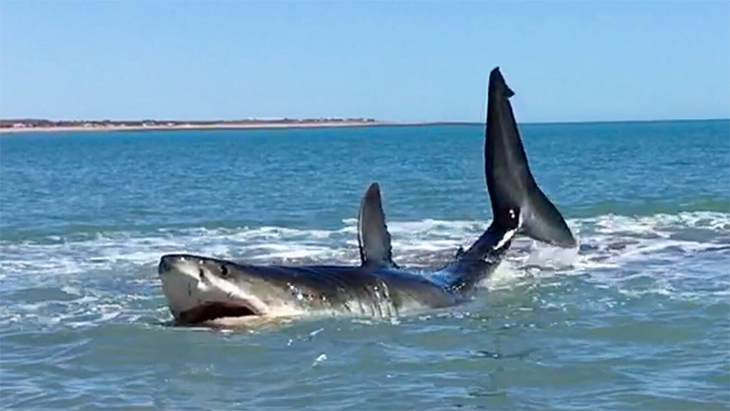By: Simple Most This video of a great white shark thrashing around in shallow water has the internet taking a collective gasp.
It’s not often that we see such up-close-and-personal video of a great white shark in action, and when we do, it’s generally hundreds of feet under the water via a brave soul holding a camera in a shark cage. But not this video!
That’s Not A Hammerhead!
In this breathtaking footage captured in May, a man and diver named Dale Pearson captures a great white shark thrashing and splashing in just 3 feet of water. He quickly determines that it’s neither a pilot whale or hammerhead as he and his friend initially suspected.
As you can see in the video below, the great white appears to be badly wounded. The 14-foot shark likely was injured by the blades of a boat propeller.
This video was taken in a remote area of the Gulf of California, sometimes called the Sea of Cortez, near the Baja California Peninsula. Here’s an approximate location from Google Maps:
As Pearson explains, “There is no phone service of any kind [there]. You can not call anyone for help.” In other words, they couldn’t call any marine wildlife experts to help tend to the shark’s wounds.
But, don’t worry. Pearson says that the shark moved continuously, and despite probably being in pain, “It had total control over where it was and how deep of water it was in.”
Experts agree with Pearson’s experience, saying that great whites are extremely tough and have wonderful healing ability. (After all, scientists think certain shark species have existed for 175 million years, so you figure they know a thing or two about survival.)
And, while many people are terrified of sharks (especially great whites), the reality is that 100 million sharks are killed by humans each year, and you are more likely to be killed by a falling coconut than a shark.
Was He Stranded Or Just Eating?
In fact, as you can see in this footage, the people in the water are not injured by the shark—but by the stingrays in the water! Ouch.
“All three people in the water that day received injuries from stingrays,” Pearson says. “After weeks of antibiotics and medications, they will recover.” (In case you still were considering approaching a shark in the water—which you shouldn’t—those stingray injuries will probably convince you to stay away!)
In fact, Pearson thinks the shark was ultimately not stranded in the shallows at all but that it was feeding on the stingrays that ended up stinging Pearson’s group.
As for the great white in this video, the story does have a happy ending. Pearson says, “After 30 minutes in the shallow water the shark swam away under its own power and was seen for the next two days.” Back for more Stingray supper, it is presumed.
Check out the video below (but be warned, Pearson is totally taken aback by his shark encounter, so he uses some pretty choice language! If you don’t like swear words, you can simply mute your device and still enjoy this awesome footage).
Whew. Glad to see this beautiful creature lived to swim another day. To learn more about sharks and shark conservation efforts, please visit Project Aware.
And, by the way, stingrays are not likely to attack unless provoked or accidentally stepped on—as is often the case. While the injury from the stinger can be extremely painful and is at risk of becoming infected, stingray injuries are usually not fatal. In the case of the fatal stingray attack that killed wildlife expert Steve Irwin, the stinger had pierced his chest.







